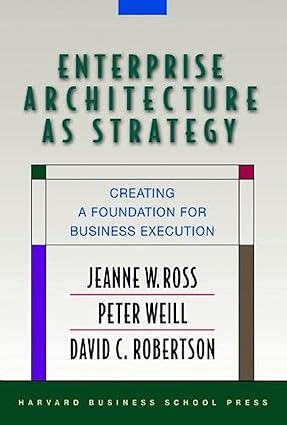This white paper explores the core principles and best practices of Enterprise Architecture (EA), drawing insights from leading works such as "The Practice of Enterprise Architecture: A Modern Approach to Business and IT Alignment" (2nd Edition), "Getting Started with Enterprise Architecture: A Practical and Pragmatic Approach to Learning the Basics of Enterprise Architecture," and "Enterprise Architecture as Strategy: Creating a Foundation for Business Execution."
Enterprise Architecture: A Foundation for Business Success
This white paper explores the core principles and best practices of Enterprise Architecture (EA), drawing insights from leading works such as "The Practice of Enterprise Architecture: A Modern Approach to Business and IT Alignment" (2nd Edition), "Getting Started with Enterprise Architecture: A Practical and Pragmatic Approach to Learning the Basics of Enterprise Architecture," and "Enterprise Architecture as Strategy: Creating a Foundation for Business Execution."
1. Introduction
Enterprise Architecture (EA) is a discipline that bridges the gap between business strategy and IT capabilities. It provides a holistic view of an organization, enabling effective planning, execution, and governance of business initiatives. This white paper will delve into the key concepts, benefits, and best practices of EA, focusing on its role in achieving business agility, driving innovation, and creating a competitive advantage.
2. Core Principles of Enterprise Architecture
- Business-Driven Approach: EA must be aligned with the organization's strategic goals and objectives. It should not be solely an IT-centric function.
- Holistic View: EA encompasses all aspects of an organization, including business processes, data, applications, technology infrastructure, and people.
- Continuous Improvement: EA is an ongoing process of continuous improvement and adaptation to changing business needs and technological advancements.
- Stakeholder Engagement: Effective EA requires active participation and buy-in from all stakeholders, including business leaders, IT professionals, and end-users.
- Value Delivery: EA should focus on delivering tangible business value by enabling innovation, improving efficiency, and reducing costs.
3. Key Benefits of Enterprise Architecture
- Improved Business Agility: Enables organizations to respond quickly and effectively to changing market conditions and emerging opportunities.
- Enhanced Decision Making: Provides a framework for informed decision-making by aligning IT investments with business priorities.
- Reduced Costs: Optimizes IT investments and minimizes redundancies, leading to cost savings.
- Increased Innovation: Fosters a culture of innovation by providing a platform for exploring new technologies and business models.
- Improved Risk Management: Identifies and mitigates potential risks associated with IT investments and operational disruptions.
- Enhanced Customer Experience: Enables organizations to deliver better customer experiences by aligning IT capabilities with customer needs.
4. Key EA Frameworks and Methodologies
- TOGAF (The Open Group Architecture Framework): A comprehensive and widely adopted framework for enterprise architecture.
- Zachman Framework: A well-known framework that provides a structured view of enterprise architecture from different perspectives.
- FEA (Federal Enterprise Architecture Framework): A framework developed by the U.S. government for use by federal agencies.
- Agile EA: An approach that emphasizes flexibility, iterative development, and collaboration.
5. Implementing Enterprise Architecture
- Define Business Strategy: Clearly define the organization's strategic goals, objectives, and key performance indicators (KPIs).
- Conduct a Business and IT Assessment: Analyze existing business processes, IT infrastructure, and technology capabilities.
- Develop an EA Roadmap: Create a roadmap for implementing EA initiatives, including timelines, budgets, and resource allocation.
- Establish Governance and Communication: Establish clear governance processes and ensure effective communication across all stakeholders.
- Monitor and Evaluate: Continuously monitor and evaluate the effectiveness of EA initiatives and make adjustments as needed.
6. Use Cases of Enterprise Architecture
- Cloud Migration: Planning and executing a successful cloud migration strategy.
- Digital Transformation: Enabling digital transformation initiatives, such as the adoption of new technologies and business models.
- Business Process Reengineering: Optimizing business processes for improved efficiency and effectiveness.
- Data Governance: Establishing data governance policies and ensuring data quality and security.
- Cybersecurity Risk Management: Identifying and mitigating cybersecurity risks across the enterprise.
7. References
- "The Practice of Enterprise Architecture: A Modern Approach to Business and IT Alignment" (2nd Edition) by John A. Zachman
- "Getting Started with Enterprise Architecture: A Practical and Pragmatic Approach to Learning the Basics of Enterprise Architecture" by Steven Spewak
- "Enterprise Architecture as Strategy: Creating a Foundation for Business Execution" by Ross J. Anderson and Jeanne W. Ross
- "TOGAF 9.2: Architecture Framework" by The Open Group
- "Zachman Framework for Enterprise Architecture" by John A. Zachman
Disclaimer: This white paper provides a general overview of Enterprise Architecture. The specific implementation and benefits of EA will vary depending on the organization and its specific needs and objectives.
This information is for general knowledge and informational purposes only. Contact keencoputer.com for details
